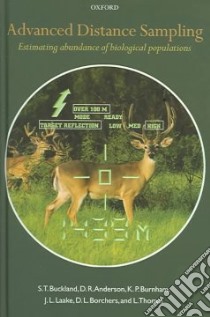Advanced Distance Sampling - 9780198507833
Un libro in lingua di Buckland S. T. Anderson D. R. Burnham Kenneth P. Laake J. L. Borchers D. L. L. Thomas edito da Oxford Univ Pr on Demand, 2004
- € 106.30
- Il prezzo è variabile in funzione del cambio della valuta d’origine
This advanced text focuses on the uses of distance sampling to estimate the density and abundance of biological populations. It addresses new methodologies, new technologies and recent developments in statistical theory and is the follow-up companion to Introduction to Distance Sampling (OUP, 2001). In this text, a general theoretical basis is established for methods of estimating animal abundance from sighting surveys, and a wide range of approaches to the design and analysis of distance sampling surveys is explored. These approaches include: modelling animal detectability as a function of covariates, where the effects of habitat, observer, weather, etc. on detectability can be assessed; estimating animal density as a function of location, allowing for example animal density to be related to habitat and other locational covariates; estimating change over time in population abundance, a necessary aspect of any monitoring programme; estimation when detection of animals on the line or at the point is uncertain, as often occurs for marine populations, or when the survey region has dense cover; automated generation of survey designs, using geographic information systems; adaptive distance sampling methods, which concentrate survey effort in areas of high animal density; passive distance sampling methods, which extend the application of distance sampling to species that cannot be readily detected in sightings surveys, but can be trapped; and testing of methods by simulation, so the performance of the approach in varying circumstances can be assessed. Authored by a leading team, this text is aimed at professionals in government and environment agencies, statisticians, biologists, wildlife managers, conservation biologists and ecologists, as well as graduate students, studying the density and abundance of biological populations.
Informazioni bibliografiche
- Titolo del Libro in lingua: Advanced Distance Sampling
- Lingua: English
- Autori : Buckland S. T. Anderson D. R. Burnham Kenneth P. Laake J. L. Borchers D. L. L. Thomas
- Editore: Oxford Univ Pr on Demand
- Collana: Oxford Univ Pr on Demand (Hardcover)
- Data di Pubblicazione: 04 Novembre '04
- Genere: MATHEMATICS
- Argomenti : Population biology Statistical methods Sampling (Statistics Population Dynamics
- Pagine: 416
- Dimensioni mm: 234 x 152 x 25
- ISBN-10: 0198507836
- EAN-13: 9780198507833


